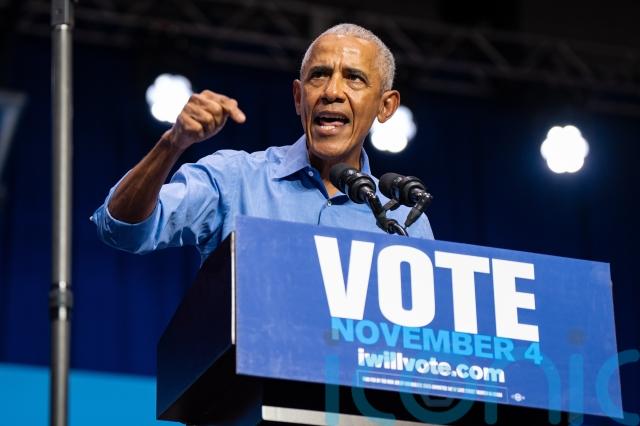
California voters have approved new congressional district boundaries, delivering a victory for Democrats in the state-by-state redistricting battle that will help determine which party wins control of the US House of Representatives in 2026.
The approval of Proposition 50 gives Democrats a shot at winning as many as five additional seats, just enough to blunt Texas Republicans’ move to redraw their own maps to pick up five Republican Party seats at President Donald Trump’s urging.
Texas’s move and California’s response have kicked off a flurry of redistricting efforts around the country, with Republican states appearing to have an edge.

Deeply blue California is the Democrats’ best opportunity to make up seats.
Midterm elections typically punish the party in the White House, and Mr Trump is fighting to maintain his party’s slim House majority.
Republicans hold 219 seats to the Democrats’ 213.
Tuesday’s results mark a political victory for Democratic governor Gavin Newsom, who cast the measure as an essential tool to fight back against Mr Trump and protect American democracy.
Speaking to reporters in Sacramento, Mr Newsom cast the California vote as part of a broader national rejection of Mr Trump’s policies that saw Democratic governors elevated in New Jersey and Virginia.
But he warned the more consequential battle would come next year.
If Democrats win the House majority, they can “end Donald Trump’s presidency as we know it”, Mr Newsom said.

“It is all on the line, a bright line, in 2026″.
California’s Proposition 50 asked voters to suspend House maps drawn by an independent commission and replace them with rejigged districts adopted by the Democratic-controlled legislature.
Those new districts would be in place for the 2026, 2028 and 2030 elections.
The recast districts aim to dilute Republican voters’ power, in one case by uniting rural, conservative-leaning parts of far northern California with Marin County, a famously liberal coastal stronghold across the Golden Gate Bridge from San Francisco.
The measure was spearheaded by Mr Newsom, who threw the weight of his political operation behind it in a major test of his mettle ahead of a potential 2028 presidential campaign.
Former president Barack Obama urged voters to pass it as well.
“Republicans want to steal enough seats in Congress to rig the next election and wield unchecked power for two more years,” Mr Obama said in one ad.

“You can stop Republicans in their tracks.”
Critics said two wrongs do not make a right.
They urged Californians to reject the measure, even if they have misgivings about Mr Trump’s moves elsewhere.
Among the most prominent critics was Arnold Schwarzenegger, the film star and former Republican governor who pushed for the creation of the independent commission, which voters approved in 2008 and 2010.
It makes no sense to fight Mr Trump by becoming him, Mr Schwarzenegger said in September, arguing that the proposal would “take the power away from the people”.
After an early burst of TV advertising, opponents of the plan struggled to raise cash in a state with some of the nation’s most expensive media markets.
The campaign followed an unusual trajectory.

A handful of Republican congressmen who will see their districts dramatically reshaped – and their jobs endangered – mostly stayed away from the campaign spotlight.
With opponents short on cash, Mr Newsom and his supporters dominated TV screens in the critical closing weeks.
Total spending on broadcast and cable ads topped 100 million dollars, with more than two-thirds of it coming from supporters.
Mr Newsom told people to stop donating in the race’s final weeks.
Mr Trump, who overwhelmingly lost California in his three presidential campaigns, largely stayed out of the fray.
A week before the election, he urged voters in a social media post not to vote early or by mail – messaging that conflicted with that of top Republicans in the state who urged people to get their ballots in as soon as possible.
In a post on Tuesday on his social media platform, the president called the state’s voting process “RIGGED” and warned that it was “under very serious legal and criminal review. STAY TUNED!”

Secretary of state Shirley Weber called that “another baseless claim”.
Congressional district boundaries are typically redrawn every 10 years to reflect population shifts documented in the census.
Mid-decade redistricting is unusual, absent a court order finding fault with the maps in place.
Beyond Texas, Republicans expect to gain one seat each from new maps in Missouri and North Carolina, and potentially two more in Ohio.
Five other Republican-led states are also considering new maps: Florida, Indiana, Kansas, Louisiana and Nebraska.
On the Democratic side, Colorado, Illinois, Maryland, New York and Virginia have proposals to redraw maps, but major hurdles remain.
A court has ordered new boundaries be drawn in Utah, where all four House districts are represented by Republicans, but it remains to be seen if the state will approve a map that makes any of them winnable for Democrats.
Subscribe or register today to discover more from DonegalLive.ie
Buy the e-paper of the Donegal Democrat, Donegal People's Press, Donegal Post and Inish Times here for instant access to Donegal's premier news titles.
Keep up with the latest news from Donegal with our daily newsletter featuring the most important stories of the day delivered to your inbox every evening at 5pm.